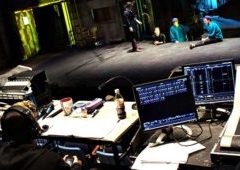 I’ve talked about the interplay between actors and crew during a performance; how everything needs to come together to deliver an experience to the audience. None of that experience is accidental. All of it is designed; the actors’ lines, where they move, sets, costumes, props, lights are all the product of careful thought.
I’ve talked about the interplay between actors and crew during a performance; how everything needs to come together to deliver an experience to the audience. None of that experience is accidental. All of it is designed; the actors’ lines, where they move, sets, costumes, props, lights are all the product of careful thought.
All of these elements first come together during tech rehearsal. Tech rehearsal is when you work out all of the details that the audience won’t be aware of yet are essential to their experience. As an example, consider just the lighting in a scene. Is it a beautiful morning in Oklahoma? The lights won’t simply be bright; the color balance will be some version of straw or amber. That level and balance gets worked out and adjusted during tech.
In the theater, those environmental elements are designed and controlled. I think this is where I first began to tune into the role of the environment on performance. We tend to think of the organizational environment as a fixed background if we think of it at all.
The theater teaches a different lesson. Any element is potentially mutable. And it is the interaction of multiple elements that contributes to the overall effect. Eventually, this leads you to a systems perspective on performance. Sure the lights need to be bright enough to see the performers, but what color balance do you want to set the tone?
One of the particular challenges in organizational settings is that we lack the theater’s appreciation for the complexity of how elements interact. Or for the time it takes to understand and adapt to a new arrangement of elements. Instead, we are likely to turn down the lights or move the sets in the middle of a live performance and wonder why the actors are angry and the audience has left.